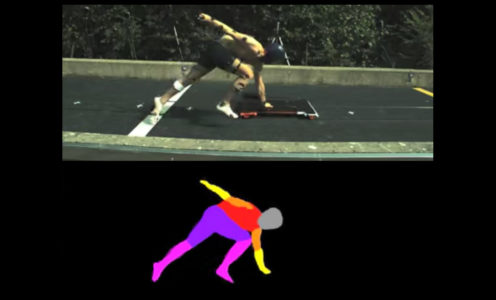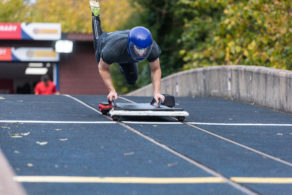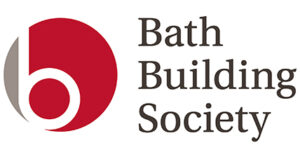Markerless motion capture technology adds to British Skeleton’s cutting-edge training approach at UK’s only push-start track in Bath

Researchers at the University of Bath have been working with GB skeleton athletes based at the Team Bath Sports Training Village to develop a new type of motion capture technology that can accurately track the performance of the athlete during the push-start phase of performance.
Skeleton is a winter sport where athletes rapidly accelerate on ice whilst pushing a sled before launching forwards on to it and navigating the corners of the track at speeds of up to 90 mph. Improvements of fractions of a second made at the start can make all the difference at the finish line. Therefore, it is useful for both athletes and their coaching team to be able to monitor the performance of athletes during this start phase and how they respond to training.
Standard methods of optical motion capture, using multiple reflective markers on the athlete and the sled to measure their movement in 3D space, are time consuming to set up and can interfere with the athlete’s natural performance.
 To overcome this, researchers at CAMERA, the University of Bath’s motion research centre, have developed a non-invasive markerless system using computer vision and deep learning methods to measure velocity and estimate poses by identifying body landmarks from regular image data.
To overcome this, researchers at CAMERA, the University of Bath’s motion research centre, have developed a non-invasive markerless system using computer vision and deep learning methods to measure velocity and estimate poses by identifying body landmarks from regular image data.
The method was used at the University’s unique push-track training facility, a concrete slope with straight metal rails, which allows athletes to train off-season using a wheeled practice sled.
The researchers used a set-up of nine cameras along both sides of the push-track for the markerless system, and compared measurements with those obtained using the conventional 15 camera marker-based camera system.
They tested the system on 12 athletes for 33 push trials and found that there was very good agreement in the data from both systems (measured sled and athlete velocities were within 0.015 and 0.029 m/s, respectively), validating the use of the markerless method as a non-invasive and accurate alternative to the traditional marker-based system.
Dr Laurie Needham, a post-doctoral researcher within CAMERA, said: “Our latest computer vision system allows us to break out of the laboratory and take biomechanics into the wild. The non-invasive nature of this approach not only means that we can capture push-start information without interfering with the athlete’s training session but we can do so in way that conforms with the current need for social distancing.”
Dr Steffi Colyer, from the University’s Department of Health, said: “Conventional (marker-based) technologies, which we use every day in our laboratory research, are not feasible in many elite sports training and competition environments and so the future of sports biomechanics lies in finding accurate and unobtrusive markerless solutions. Our system can provide information about British skeleton athletes’ start performances that was previously inaccessible to them and their coaches.
“We’d like to thank the British Bobsleigh & Skeleton Association for their time and support for this project. We hope that our system can be used by athletes in the future to monitor and improve their performance on the track.”
Danny Holdcroft, Head of Performance Innovation and Applied Research at the British Bobsleigh & Skeleton Association, said: “Our continuing relationship with the University of Bath is something that we hold in high regards and value greatly as we see to support our athlete aspirations of winning Olympic Gold Medals in 2022 and 2026. The CAMERA project is an exciting piece of our larger jigsaw and will undoubtedly help us further explore beyond our current performance boundaries.”
The research was partly funded by CAMERA, a RCUK Centre for the Analysis of Motion, Entertainment Research and Applications, and was presented at the 38th International Conference of ISBS (International Society of Biomechanics in Sport) on 21-25 July 2020.




